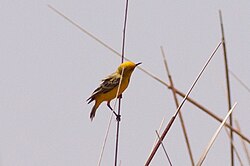The yellow chat occurs patchily throughout northern Australia, ranging across the arid zone from north-eastern South Australia and south-western Queensland to the north-west of the Northern Territory. There are some isolated populations in eastern Queensland and in north-west Western Australia. [16] Their habitat is subject to high temperatures for most of the year and contains marshy plains vegetated with saltbush, rank grasses, or cumbungi reeds. [3] [9] These marshes have been formed by marine lagoons or inland artesian bore drains, creating a saline environment. [3] This distribution includes the central arid region and the hot, subhumid monsoonal region. Most of the annual rainfall falls during the summer monsoon, leaving the remaining six months of the year with little rainfall. [3]
Arid zone adaptations
It has been presumed that yellow chats would encounter problems living in their harsh, arid environment with high ambient temperatures, low ambient humidities and small amounts of surface water. [3] Birds with small body weights are predicted to have high metabolic rates. [17] Furthermore, small body weights will also lead to a higher rate of evaporative water loss compared to larger birds. [18] These predictions suggest that the small body size of the yellow chats combined with their hot, dry, arid environment will result in heat stress and a high loss of water. This could be detrimental in their habitat where water is scarce. [3]
Despite these predictions, yellow chats are able to prosper in their hot, arid habitat. Studies have found that the physiology of the yellow chats differs from other species of passerines with adaptations to help them cope with the challenging environment. [3] Studies have shown that they are able to reduce their metabolic rate and evaporative water loss. [19] The metabolic rate is mostly controlled by the concentration of thyroid hormone. [20] Yellow chats have adapted to have lower levels of this hormone circulating in their body, resulting in a slower metabolism. [19] This adaptation enables them to thrive in their harsh hot and dry environment.
Another suggested adaptation to help yellow chats survive in the arid region is their brush tongue. The brush tongue may be an adaptation to aid in retrieving drinking water. [19] It allows the birds access to dew and the capability to drink thin water films, such as water seepages on surfaces of plants. [19] Furthermore, the colour of their plumage is an adaptation aiding in their thermoregulation. Black pigments have been observed to increase heat absorption, with lighter colours absorbing less heat. [21] This suggests that the yellow colouring of the yellow chats is an adaptation to reduce the amount of heat absorbed in their body. [19]


